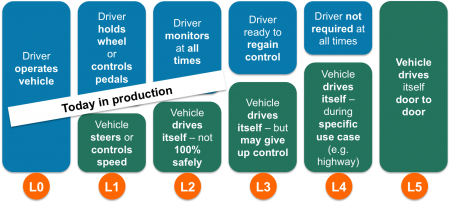Biggest myth in automotive? Ethernet won’t work for ADAS
One key application of using Ethernet in the car is to connect all the automotive cameras to the head unit, displays, and other electronic control units in the car. Replacing traditional wiring with Automotive Ethernet has many advantages. A joint study by Broadcom and Bosch estimated that Ethernet reduces connectivity cost up to 80 percent and cabling weight up to 30 percent. There are a few myths surrounding Ethernet and ADAS that are hurting adoption though. Here are three of them that we ran across: Ethernet adds too much latency, Ethernet ICs are too expensive, and Ethernet requires video compression, which confuses the computer vision algorithms. In this article we debunk these myths one by one, and show that automotive Ethernet is here to stay.
New kid on the block: the AutoSens conference
Robert Stead from Sense Media is organizing the new 2-day AutoSens automotive event, and he’s hit the ground running. There will be speakers from industry heavyweights such as GM, Toyota, BMW, Bosch, Volvo, Intel, Jaguar Land Rover, Valeo, ON, ST, and Qualcomm. Our own Marco Jacobs will present a talk titled ”Visual processing crucial to ADAS: applications, architectures and algorithms”.
The day prior to the event the IEEE Working Group (Project 2020) will have its first meeting. This group focuses on specifying methods and metrics for measuring and testing automotive image quality.
We’re looking forward to the event and connecting with the automotive imaging community. Please join us at the event, which is nicely hosted at the AutoWorld vintage car museum in Brussels, Belgium.
Register now with the AS_2016_SPEAK_15 code for a 15% discount.
What are all these automotive cameras doing?
We all know that our future cars will have many cameras on board to make our rides safer and more comfortable. But what functions will these cameras perform and where do they go?
We’ve spoken about SAE’s 6 levels of automation before. The levels are primarily defined by who has control over the steering wheel and pedals and under which circumstances. At Level 0 the vehicle is solely operated by the driver, while at level 5 the car is completely driven by electronics. These 6 levels provide a nice framework for looking at where all the cameras in cars will go and what they’ll be doing.
Even at L0 we see quite a few opportunities in the market. At level L0 the driver is operating the vehicle 100%, so it’s primarily about about extending visbility, making it easier for the driver to see and understand what’s going on around the car.
Industry news
Germany to require ‘black box’ in autonomous cars
Germany plans new legislation to require manufacturers of cars equipped with an autopilot function to install a black box to help determine responsibility in the event of an accident. The fatal crash of a Tesla car in Autopilot mode has increased the pressure on industry executives and regulators to ensure that automated driving technology can be deployed safely. Under the proposal, drivers will not have to pay attention to traffic or concentrate on steering, but must remain seated at the wheel so they can intervene in the event of an emergency.
Read the article
New royalty free video compression backed by industry heavyweights
Recent advances in video codecs have fallen short of historic gains but experts remain hopeful advances will pick up steam in the future. The ISO has started to define a new video codec for release by 2020. Current work shows 15-20% gains over today’s leading edge codec, HEVC. Google expects to turn over its work on VP-10 to the Alliance for Open Media (AOM), which aims to craft it into AV1, a mainstream, royalty-free video codec. Founding members of the group include Amazon, ARM, Cisco, Intel, Microsoft, Netflix and Nvidia.
Read the article
Japan allows mirrorless cars to hit the road
Go to any auto show and there will likely be a futuristic concept car that has ditched its rearview or sideview mirrors. Mirrorless cars — vehicles that drop old-school glass mirrors in favor of video screens — have been proposed for years by stylists and engineers wanting sleeker looks as well as improved safety and fuel efficiency. Last month, the proposals came closer to reality in Japan, which became one of the first markets allowing vehicles to use cameras instead of mirrors.
Read the article
Upcoming events
| AutoSens | September 20-22, Brussels | Come see our talk and meet at this key automotive sensor event. |
| Ethernet & IP @ Automotive Technology Day | September 20-21, Paris | Meet us at the automotive Ethernet event of the year. |
Schedule a meeting with us by sending an email to sales@videantis.com. We’re always interested in discussing your video and vision SOC design ideas and challenges. We look forward to talking with you!
Was this newsletter forwarded to you and you’d like to subscribe? Click here.



